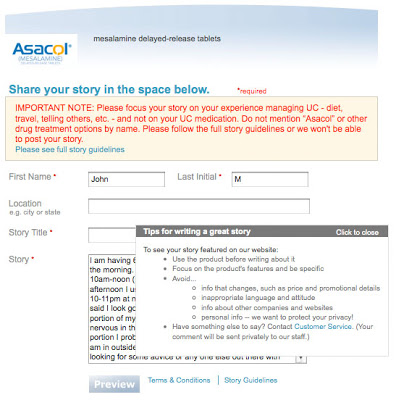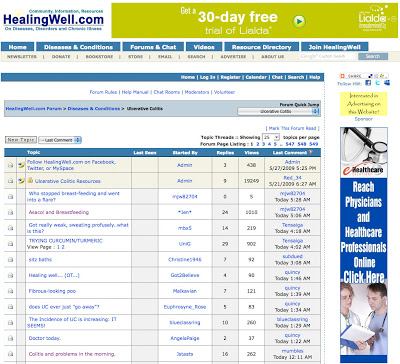Lately, my Twitter friends have alerted me to all sorts of examples of pharmaceutical companies delving into social media for marketing and corporate communications. I’d like to focus on just one example here: the Asacol Community for UC Patients. UC stands for ulcerative colitis – a form of inflammatory bowel disease. Asacol is a product marketed by Procter & Gamble (P&G) for the treatment of UC.
“In the Asacol Community, consumers are encouraged to provide stories or to ask questions,” notes Ellen Hoenig Carlson in the AdvanceMarketWorx Blog (see “Pharma Marketers: Think You Can’t Do Moderated Chat?“). “Content is carefully moderated per the guidelines, but consumers can rate and vote on story content and answers.”
The Asacol Community reminds me of other efforts of pharmaceutical marketers to build “communities” within their product or disease awareness websites, YouTube, or FaceBook pages. They all share one thing in common: they are FAUX communities that have practically none of the characteristics of a REAL community. Although Ellen calls this a “chat,” there is NO chatting going on. You can submit a story and that’s about it.
Here’s why this is NOT a real community and NOT a real chat:
- You CANNOT submit a comment in response to a story,
- Your “vote” as to whether or not the story was useful is NOT counted. No matter how many times I voted “No”, the counter still said “28 of 32 people found this story helpful” (probably a made-up statistic), and
- When I submitted a story, I was notified “If your story follows submission guidelines, it will be posted to the site within 3 business days.” That turnaround time is not conducive to community-building.
Perhaps because of these reasons, there are only two (2) stories on the site that appear to have been submitted by visitors. But I suspect that these stories were plants written by P&G agents and not real people. In a real community or chat (see below), I could carry on a conversation with the person and find out if he or she is real or not.
A Dysfunctional Community
Not only can’t I carry on a conversation with people posting stories to the Asacol UC Community, I cannot even have a meaningful conversation with P&G or Asacol via the “community.”
When I submit a story, for example, I am not asked for my email address so that I can be notified if my story was accepted or not. That’s just a common courtesy.
In fact, P&G is sending confusing messages regarding submission of email addresses. Does it want to collect email addresses or doesn’t it?
The guidelines for story submission says “you shall not submit any content…that includes information that references…email addresses,” among other things. Interestingly, however, the Terms & Conditions suggest that you can submit your email address with a story: “By submitting your email address in connection with your story, you agree that Asacol and its third party service providers may use your email address to contact you about the status of your story and other administrative purposes.”
I’m totally confused by all this! Luckily, most consumers never read guidelines or Terms and Conditions as carefully as I do, otherwise they would realize how dysfunctional the Asacol Community for UC Patients really is.
A More Serious Problem
Aside from all this, I notice a peculiar problem with the story submission process, which is apparently provided by “Bazaarvoice, a company who provides a framework for capturing, managing, marketing and leveraging authentic user-generated content so that brands can capture and leverage their customer ‘word of mouth’ asset,” according to Ellen.
When you submit a story, you can click on a “Helpful Tips” link next to the subject line. I am the sort of person who needs all the help he can get, so I clicked on it. The screen capture below reveals what I found.
Although P&G’s guidelines for submitting stories expressly prohibits mentioning product names, let alone benefits, the help message contradicts that warning and says that you have a better chance of getting your story published if you “Use the product before writing about it” and “Focus on the product’s features and be specific.”
This is obviously some kind of bizaare glitch in Bazaarvoice’s software, which was obviously NOT modified appropriately for pharmaceutical company use.
P&G should thank me Profusely & Gratefully for pointing this out (I used to be a software tester and documentation expert; hire me next time before you launch a website!).
Aside from these “user-generated” stories, the Asacol site includes “Success Stories,” which are obviously well-crafted stories written by P&G or its agents about seemingly real people. Links to these stories appear next to the link for “Shar[ing] Your Story,” thereby giving visitors the impression that the “success stories” were submitted by people like them. Could be, I don’t know. But have these people been compensated by P&G for use of their stories and images? From the Terms I guess that there is no compensation: “For any content that you submit, you grant Asacol a perpetual, irrevocable, royalty-free, transferable right and license to use, copy, modify, delete in its entirety, adapt, publish, translate, create derivative works from and/or sell and/or distribute such content and/or incorporate such content into any form, medium or technology throughout the world without compensation to you.”
All these “stories,” whether actually submitted by real people or not, contribute to a feeling of community on the site, but it is a faux and dysfunctional community at best. NOTE: I’ve written about faux pharma social media before (see “Faux Social Marketing: Have Your Cake and Eat It Too!“).
What should a REAL UC Community look like?
I found one on the HealingWell.com site (see screen capture below). This is obviously a real, vibrant, and up-to-date community of people suffering from UC. There are hundreds of topics being discussed and also products by name. That, however, did not discourage Shire from advertising Lialda, its UC product, prominently on the site (although when you click on the ad, you are directed to a survey instead of the promised free trial!). I am sure that Shire gets much better ROI out of that one ad than P&G gets out of its UC “Community!”










![6 Digital Tools at the Center of Healthcare Digitalization [INFOGRAPHIC]](http://ec2-54-175-84-28.compute-1.amazonaws.com/pharma-mkting.com/wp-content/uploads/2021/04/6DigitalTools_600px-100x70.jpg)




